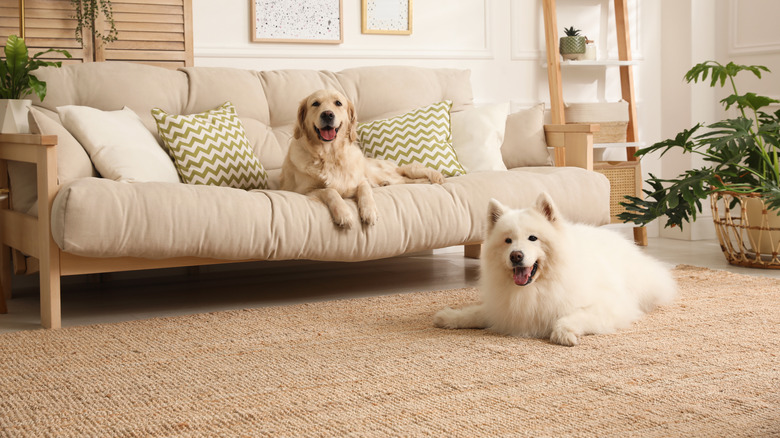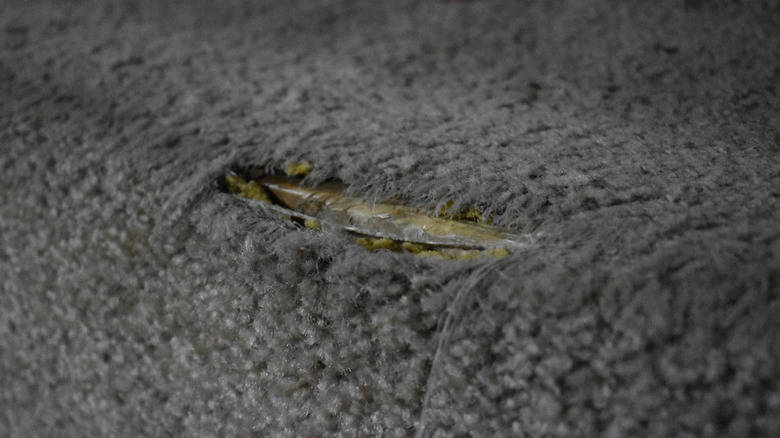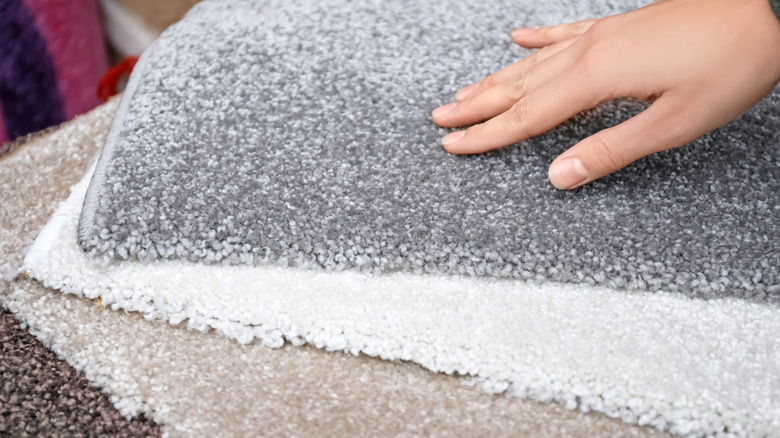The Fastest Repair For A Carpet Ripped Up By Your Dog
Dogs add so much to our lives, with a 2018 poll reported by The Washington Post revealing that 36% of surveyed dog owners identified as very happy, as opposed to only 32% of non-pet owners. Furthermore, dog owners are twice as happy as cat owners, with only 18% reporting they were very happy.
However, with that joy comes the occasional pet-induced crisis, whether that's a house training accident, a torn-up shirt or chewed-up shoe, or a ripped-up carpet. Playful pups, especially larger dogs or those with sharper claws, can easily stain or tear up your carpets. While the former is usually treatable with a carpet cleaner or a shopping trip, the latter can be a very costly concern. Forbes estimates that carpet installation can cost anywhere from $700 to $2,000 for a 200-square-foot room. Don't be scared by the high price tag, though, because you likely don't need to replace your carpet over a simple tear.
Hide small tears
A tear in your carpet is definitely an annoying problem. On top of being unsightly, the untreated tear can result in larger rips. Dirt, debris, and spills can then penetrate through the carpet to the backing, which can cause even more issues. Luckily, there are much more cost-efficient methods for fixing the tear that don't require hundreds of dollars.
According to Appliance Analysts, the way to fix the tear depends on the severity. If your dog just simply tore a line in the carpet, the fix is very simple. This level of damage should only be visible by loose threads or loops in the carpet. Most well-made carpets should be thick enough that, once you remove the loose threads, you can cover it up with extra carpet. Use scissors — preferably sewing shears — to cut off the loose ends, and simply use a vacuum to suck up the extra fibers and blend the tear into the rest of the carpet.
For slightly more significant rips and tears, or if your carpet is pulled up from the backing, you'll have to use a hot melt carpet tape, which, as the name suggests, is a carpet adhesive that melts under heat, bonding the carpet back together. Measure the rip and cut the length out in tape. Add the tape where the carpet meets the floor or other carpet, and then use an iron to melt it and seal the carpet.
Patch larger rips
Larger rips that can't be simply glued together will require a bit more elbow grease to fix, but if done right, you won't need to invest in a costly carpet repair. This method may only be doable for those with newer carpets, though. Per Appliance Analysts, bigger tears can be covered up by adding a patch of carpet over the hole.
Begin by ensuring you can get a match to your current carpet, or you'll have a discolored square patch. Use a carpet knife and cut out a square of your carpet large enough to encompass the damage. Contact your carpet manufacturer and order a square of carpet a little larger than the one you cut out. Grab a piece of cardboard, cut it a little larger than the hole, and then slide it under the carpet. Using a pen, trace the hole onto the cardboard, and then cut it to that size — this will be used as a size guide for your carpet sample. Cut your carpet sample to the size of the cardboard and use hot melt carpet tape and an iron to adhere it to the exposed backing. Finally, vacuum to blend the new sample into the surrounding fibers.


